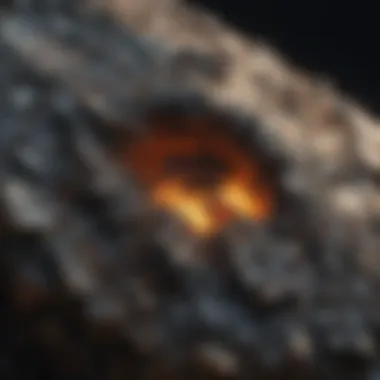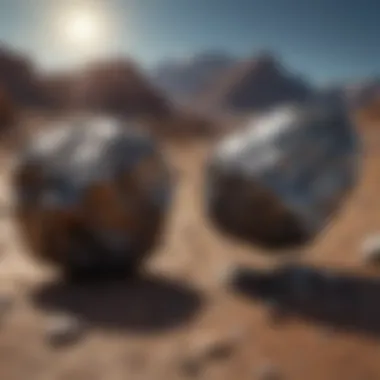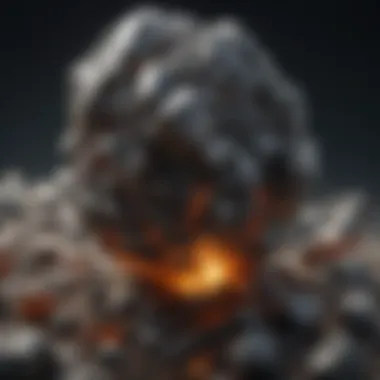Identify Meteorites: A Comprehensive Guide


Intro
Identifying meteorites is an intriguing journey into the cosmos. This guide serves to illuminate the distinctive features that set meteorites apart from regular rocks. It is crucial for enthusiasts and collectors to grasp not only the physical traits but also the context surrounding these celestial objects. A systematic approach enhances the chance of accurate identification, ensuring that one does not confuse a valuable meteorite with a terrestrial counterpart.
Rock and Fossil Identification
When exploring the vast terrains in search of meteorites, understanding rock and fossil identification enhances one’s capabilities. While the focus here is on meteorites, it is beneficial to have a foundational knowledge of rocks and fossils.
Types of Rocks and Fossils
Meteorites often exhibit unique characteristics. However, the earth contains numerous rock types. Familiarizing yourself with igneous, sedimentary, and metamorphic rocks can help you avoid misidentifications. Additionally, fossils vary widely; some are well-formed, while others may appear as mere imprints. In this section, we will focus primarily on igneous rocks, as many meteorites share similar origins.
Characteristics to Look For
When evaluating potential meteorites, some key characteristics stand out:
- Density: Most meteorites have a higher density than typical earth rocks. A quick density test can help distinguish them.
- Magnetism: Some meteorites contain metallic elements, making them magnetic.
- Fusion crust: A distinguishing feature, this thin, dark layer forms when a meteorite enters the Earth’s atmosphere, indicating its extraterrestrial origin.
Tools for Identification
Utilizing the right tools can facilitate the identification process:
- Magnifying glass: Helps in examining surface features.
- Scale: For weighing specimens, as denser objects tend to weigh more.
- Compass: Assists in the orientation of magnetic fields and features.
Understanding the physical traits of meteorites provides a significant advantage when identifying these celestial objects.
Collecting Tips and Techniques
Successfully collecting meteorites entails more than just wandering in areas with potential. Strategy is essential.
Best Practices For Collecting
Approach collecting with care:
- Always research the legality of collecting in your region.
- Document your findings to create a collection history.
- Follow ethical collecting practices to preserve natural habitats.
Locating Prime Collecting Sites
Meteorites can be found in several environments:
- Deserts: Regions like the Sahara or Atacama provide ideal conditions, as the lack of vegetation aids visibility.
- Antarctica: The ice preserves meteorites remarkably well, and expeditions often yield significant finds.
How to Safely Extract Specimens
Extracting specimens requires patience:
- Use tools gently to avoid damaging the meteorite.
- Collect samples in a clean, dry place to prevent contamination.
- Keep the original location noted for scientific and personal understanding.
Preservation and Display
Once collected, preserving and displaying meteorites is vital for their longevity.
Techniques for Preserving Rocks and Fossils
- Store in a cool, dry environment to prevent deterioration.
- Use acid-free materials for storage, avoiding anything that can react with the specimens.
Proper Storage Methods
- Display cases with UV protection help in minimizing damage from light.
- Avoid direct sunlight, which can fade the colors and details of the meteorites.
Creative Display Ideas
Consider these setups:
- Use shadow boxes for artistic presentation.
- Label individual specimens for educational purposes, combining aesthetics with informative value.
Geological Insights


A deeper comprehension of geological formations adds richness to your collection.
Geological Formations and Processes
Understanding the origin of meteorites starts from their formation in space. The processes that led to their creation are of immense value.
Historical Significance of Rocks and Fossils
Many meteorites have significant historical contexts, including interactions with human history.
Notable Discoveries in the Field
The field of meteorite discovery is diverse, including instances like the Allende meteorite and its insights into the solar system's formation. Each specimen tells a story worth exploring in depth.
In summary, identifying meteorites combines a love of science with the thrill of exploration. Through proper knowledge and techniques, one can distinguish valuable specimens from ordinary rocks. This guide aims not only to educate but also to inspire further exploration into the fascinating field of meteorite identification.
Prolusion to Meteorites
Meteorites are not just simple rocks; they are remnants of the solar system's history. Understanding meteorites is essential for anyone interested in geology or celestial science. This section sets the foundation for recognizing and identifying these extraterrestrial objects.
What are Meteorites?
Meteorites are solid fragments from meteoroids, which are smaller than asteroids. When meteoroids enter Earth’s atmosphere, they are often vaporized due to friction with air. However, some survive this perilous journey and land on the Earth’s surface. These surviving fragments are what we identify as meteorites.
Meteorites can be classified into three main categories based on their composition: stony, iron, and stony-iron. Stony meteorites, consisting mostly of silicate minerals, are the most common type. Iron meteorites, composed mainly of iron and nickel, are less frequent, while stony-iron meteorites contain both metal and silicate components. Their diverse structures and compositions provide valuable information about the early solar system.
The Importance of Meteorite Identification
Identifying meteorites is crucial for several reasons. Firstly, meteorites can provide insight into the formation and evolution of our solar system. By studying their composition and structure, scientists can learn about the conditions present during the early days of planetary formation.
Moreover, meteorites hold a significant position in both scientific research and cultural heritage. Many collectors seek to acquire meteorites due to their rarity and scientific value. Accurate identification ensures that enthusiasts know the worth and significance of their specimens. Additionally, there are legal considerations related to the collection and sale of meteorites. Understanding how to identify meteorites helps collectors navigate these regulations and avoid mistakenly acquiring terrestrial rocks or imitations.
"Meteorites are not just rocks; they are narratives of cosmic history."
In summary, the introduction to meteorites provides the groundwork for understanding their nature and importance in both science and culture. Recognizing the significance of meteorites opens pathways to deeper inquiries into planetary science and our place in the universe.
Physical Properties of Meteorites
Understanding the physical properties of meteorites is crucial for both enthusiasts and collectors. Meteorites possess unique characteristics that distinguish them from common terrestrial rocks. Recognizing these properties aids in accurate identification and enhances the appreciation of these extraterrestrial specimens. This section will deep dive into the key physical traits of meteorites, emphasizing visual characteristics, density, weight, and magnetism.
Visual Characteristics
Color Variations
Color variations in meteorites depend on their mineral composition. Common colors include dark browns, blacks, or even greenish hues. This diversity in color can assist in distinguishing meteorites from Earth rocks. For example, many stony meteorites exhibit dark surfaces due to their high iron content. Understanding these nuances is particularly helpful in the initial identification process. However, misleading conclusions can arise, as some terrestrial rocks can mimic these colors. Therefore, visual inspection alone is not enough for definitive identification.
Surface Texture
The surface texture of meteorites can vary significantly. It ranges from smooth and glassy to coarse and rough. A key characteristic is the presence of fusion crust, which often forms during atmospheric entry. This thin outer layer appears glossy and can help identify meteorites. Recognizing different textures can guide enthusiasts in their identification journey. However, surface texture can deteriorate over time due to weathering, complicating the identification process.
Weathering Patterns
Weathering patterns on meteorites reveal their exposure history. These patterns manifest as pitting, rusting, or even fracturing. Certain meteorites show distinctive weathering due to the environment in which they landed. For instance, iron meteorites might exhibit rust due to prolonged exposure to moisture. Understanding these patterns not only aids in identification but also sheds light on the meteorite's journey through space and time. Nevertheless, interpreting weathering patterns can be challenging, requiring experience and knowledge.
Density and Weight
Comparison with Common Rocks
Density is a fundamental property that helps distinguish meteorites from Earth rocks. Meteorites generally have a higher density due to their metallic content. For instance, iron meteorites can weigh significantly more than similar-sized terrestrial rocks. Recognizing this difference in weight is beneficial when examining potential meteorite specimens. However, density alone does not confirm a meteorite, as some dense Earth rocks exist.
Specific Gravity Tests
Conducting specific gravity tests is a straightforward yet effective method for identifying meteorites. By measuring an object's weight in air and water, collectors can calculate its specific gravity. Most meteorites have a distinct range of specific gravity compared to ordinary rocks. This method offers a quantitative approach to identification, but it requires basic lab equipment. Non-specialized enthusiasts might find this less accessible, limiting its practicality in the field.
Magnetism
Identifying Magnetic Meteorites


Many meteorites are magnetic, primarily due to their iron content. Identifying magnetic meteorites involves using a simple magnet. If a rock is attracted to the magnet, there is a higher chance it is a meteorite. This method is quick and effective, especially when dealing with suspected specimens. However, not all meteorites are magnetic, and some terrestrial rocks may also be responsive. Thus, magnetism should be part of a broader identification strategy.
Non-Magnetic Meteorites
Not every meteorite is magnetic, which can complicate identification. Non-magnetic meteorites often include certain stony meteorites and stony-iron types. Recognizing these meteorites demands greater scrutiny. Enthusiasts should look for other properties, such as visual characteristics and density. Non-magnetic meteorites contribute to the overall diversity of meteorites but also require diligent examination to avoid misidentification.
Understanding the physical properties of meteorites provides valuable insight into their origins and enables precise identification, paving the way for enhancing both knowledge and appreciation in the field.
Types of Meteorites
Understanding the different types of meteorites is crucial for collectors and enthusiasts. Each type not only has unique characteristics but also reveals information about our solar system and the processes that formed these celestial objects. Knowing how to distinguish between stony, iron, and stony-iron meteorites aids in accurate identification and can enrich one's collection through diversity and knowledge.
Stony Meteorites
Stony meteorites are the most common type, comprising about 94% of all meteorites found. They are further divided into two groups: chondrites and achondrites.
- Chondrites contain small, round particles called chondrules. These are some of the oldest materials in the solar system, formed from molten droplets that cooled quickly.
- Achondrites, on the other hand, have undergone significant alteration or differentiation. They often resemble terrestrial rocks and are typically derived from differentiated parent bodies, like asteroids.
The identification of stony meteorites can be based on their overall appearance, texture, and mineral composition. They exhibit a variety of colors, ranging from dark to light shades, and may have a rough or smooth texture. Recognizing these traits is essential for collectors.
Iron Meteorites
Iron meteorites, though less common than their stony counterparts, are significant due to their high concentration of metallic elements, primarily iron and nickel. A striking characteristic of iron meteorites is their unique internal structure, known as the Widmanstätten pattern. This pattern forms during slow cooling and solidification of molten iron in the parent body.
Collectors often seek iron meteorites for their distinctive aesthetic appeal and their historical value, as many ancient cultures regarded them as rare treasures. Identifying iron meteorites involves evaluating their heavy weight, metallic shine, and magnetic properties, which help differentiate them from regular terrestrial metals and rocks. Their classification can also indicate their origin—a fascinating aspect for any collector.
Stony-Iron Meteorites
Stony-iron meteorites, while less common, provide insights into the transition between rock and metal in meteorites. They are a blend of silicate minerals and metallic iron, divided into two main categories: pallasites and mesosiderites.
- Pallasites contain olivine crystals embedded in metal and are often considered the most beautiful meteorite type.
- Mesosiderites exhibit a complex mixture of both metal and silicate components due to their formation from collisions of differentiated bodies.
Identifying stony-iron meteorites can be more challenging due to their dual nature. Collectors will look for features such as the presence of olivine crystals and the distinct shine of metal within the rock matrix. The rarity of these meteorites adds to their allure, making them an essential part of a comprehensive collection.
"Each type of meteorite carries a story of its origin, offering a glimpse into the history of our solar system and beyond."
Geological Context of Meteorites
Understanding the geological context of meteorites is critical for anyone interested in identifying and studying these extraterrestrial objects. This context encompasses the source locations of meteorites and their historical significance, which adds layers of understanding beyond their physical characteristics. By exploring where meteorites come from, and their implications on Earth and the universe, collectors and enthusiasts can appreciate the intricacies of their origins and journey.
Source Locations
Asteroids
Asteroids are rocky bodies orbiting the Sun, primarily found in the asteroid belt between Mars and Jupiter. They are significant contributors to our understanding of the solar system. Many meteorites that reach Earth come from these asteroids. The key characteristic of asteroids is their variety—some are composed of metal, while others are rocky or even icy. This diversity makes them a beneficial area of study in identifying meteorites.
Unique to asteroids is the ability to preserve increasingly ancient materials. Their surfaces can contain remnants of the early solar system, offering insights into its formation. However, a disadvantage is the challenge of directly accessing these materials for study, which can limit the understanding of their exact origins.
Comets
Comets represent another source location for meteorites. They are icy bodies that release gas and dust, which can form a tail when they approach the Sun. Comets can also contribute meteorites when they break apart. The important characteristic of comets is their volatile composition, which can include water ice, organic compounds, and other materials. This makes them an intriguing target for meteorite identification.
The unique feature of comets lies in their ability to bring organic materials to Earth. Studying these meteorites could help scientists understand the origins of water and, potentially, life on our planet. However, the disadvantage is the relatively lower occurrence of cometary meteorites compared to those from asteroids.
Historical Significance
Understanding Cosmic Events
Understanding cosmic events is essential when exploring the historical significance of meteorites. These events, such as collisions and explosions, often result in the formation of meteorites. The key characteristic here is that meteorites are physical evidence of such dramatic occurrences. Their analysis can provide insights into events that shaped not only our solar system but also the broader universe.
Meteorites offer a tangible link to cosmic history, making them valuable in reconstructing events like asteroid impacts. This perspective enhances their importance beyond mere collection, as they are objects of scientific inquiry that can reveal critical information. However, one limitation is that deducing the specifics of events from meteorite data can be complex and requires careful scientific analysis.
Connection to Earth's History
Meteorites also play a significant role in connecting to Earth’s history. Many meteorites have links to earlier geological periods, providing clues about the conditions that existed at those times. The key aspect is the preservation of geological materials from asteroids or comets that can relate to past Earth conditions. This aspect is beneficial for understanding planetary evolution, including temperature changes and atmospheric shifts.
A unique feature is the dichotomy between meteorites and terrestrial rocks. Unlike Earth’s surface rocks, meteorites can retain ancient materials unmarred by geological events. While this is advantageous, it may also pose challenges, as not all meteorites are easily correlated with known historical contexts on Earth.


Understanding the geological context of meteorites not only helps in identifying them but also enriches our grasp of cosmic and terrestrial narratives.
In summary, the geological context of meteorites encompasses their source locations and their historical significance. Asteroids and comets serve as two primary origins for meteorites, each offering unique advantages and disadvantages for study. Additionally, by understanding cosmic events and connections to Earth’s history, collectors and researchers can appreciate the vast narrative encapsulated in these celestial objects.
Methods for Identifying Meteorites
Understanding the methods for identifying meteorites is vital for enthusiasts and collectors. Each approach has unique strengths, allowing individuals to distinguish these extraterrestrial samples from ordinary terrestrial rocks. By combining different identification methods, one can increase accuracy and confidence in classification.
Field Identification Techniques
Field identification techniques refer to preliminary steps taken before any laboratory analysis. They serve as the initial gauge of whether a specimen might be a meteorite.
Visual Inspection
Visual inspection is a fundamental step in identifying potential meteorites. This method involves examining the specimen for specific visual traits that are commonly associated with meteorites. Key characteristics include chondrules, fusion crust, and unusual surface textures. Visual inspection is straightforward and requires no special tools, making it a beneficial choice for beginners and seasoned collectors alike.
A unique feature of visual inspection is its accessibility. Collectors can use everyday items like a magnifying glass to assist in examination. However, this method has its limits. Some meteorites might resemble common terrestrial rocks, leading to misidentification. Therefore, visual inspection should ideally be followed by other confirmation methods.
Field Tests
Field tests are hands-on techniques that help confirm visual findings. These tests can include streak tests or magnetism assessments. A defining characteristic of field tests is their practicality; they can often be conducted in situ, without the need for transporting specimens to a lab. This makes them a convenient choice in the field.
Field tests generally offer quick results. For example, a magnetic test can reveal if the specimen responds to a magnet—indicating it could be an iron or stony-iron meteorite. However, while quick, field tests can sometimes lack the depth of laboratory techniques. They should be complemented by more thorough analyses to ensure accuracy.
Laboratory Analysis
Laboratory analysis methods provide a deeper level of scrutiny than field techniques. They are essential for confirming findings and distinguishing meteorites from terrestrial rocks.
Petrographic Microscopy
Petrographic microscopy is a precise laboratory technique that allows for detailed examination of a meteorite's mineral composition. This method involves slicing a specimen into thin sections and examining them under a powerful microscope. A key characteristic of petrographic microscopy is its ability to reveal internal mineral structures and compositions. This makes it a highly beneficial method for experts seeking to classify meteorites accurately.
The unique feature of petrographic microscopy lies in its detail. It can uncover minute features that are invisible to the naked eye. However, this process requires specialized training and access to advanced equipment, making it less accessible for casual collectors.
Chemical Composition Testing
Chemical composition testing identifies the elemental and isotopic makeup of meteorites. This method can involve techniques like X-ray fluorescence or mass spectrometry. A noteworthy characteristic of this testing is its ability to provide concrete, quantifiable data on a specimen's properties. As a result, it is regarded as a crucial component of the identification process.
Chemical composition testing excels in offering precise information. This can lead to understanding the meteorite’s origin and type. Still, these tests may be costly and time-consuming, often requiring external laboratory facilities to execute effectively.
Utilizing a combination of methods enhances the identification process. Each technique, whether field or laboratory-based, contributes valuable insights that aid in distinguishing meteorites from common rocks.
Handling and Preservation of Meteorites
Proper handling and preservation of meteorites is crucial for both collectors and researchers. Meteorites hold valuable scientific information about the early solar system and the formation of Earth. Thus, it is necessary to protect them from damage that could impede their analysis. If meteorites are not preserved under suitable conditions, their physical and chemical properties may change over time, reducing their scientific value.
Best Practices for Collection
Storage Conditions
Storage conditions of meteorites play a significant role in preservation. Meteorites should be kept in clean, dry, and stable environments. An airtight container is often recommended to minimize exposure to moisture and air. It is essential to maintain a consistent temperature and avoid direct sunlight.
The key characteristic of these storage conditions is physical protection. Keeping meteorites in a controlled environment prevents oxidation and other forms of degradation. This is a popular choice for collectors, as it allows them to maintain the integrity of their specimens over time. One unique feature is using silica gel packets within the container. This absorbs excess moisture, further safeguarding the meteorite. The advantage of having a stable environment outweighs the cost of acquiring proper storage materials.
Cleaning Techniques
Cleaning techniques for meteorites must be approached with caution. It is essential to remove only loose dirt and debris without damaging the surface. Use a soft brush or a gentle stream of air to dislodge particles. This method does not involve chemicals that may alter the meteorite's surface.
The main characteristic of these cleaning techniques is their non-invasive approach. They are beneficial as they help maintain the specimen's natural state. One unique aspect is the importance of preserving any unique features present on the meteorite's surface. Clean specimens can be more appealing for display or study. However, care must be taken to avoid over-cleaning, which can lead to loss of valuable data.
Ethical Considerations
Legal Regulations
Legal regulations regarding meteorite collection and ownership vary greatly by region. Many countries have specific laws governing the collection of meteorites, especially if they are considered to have scientific or cultural significance. Understanding and complying with these regulations is essential to avoid potential fines or confiscation of specimens.
The key characteristic of such regulations is their role in protecting natural resources. They create responsible practices for collectors, ensuring they do not exploit meteorite finds. A unique feature of these regulations is their variability across jurisdictions. This can lead to confusion among collectors about legalities. However, staying informed fosters ethical collection practices, giving collectors peace of mind.
Respecting Cultural Heritage
Respecting cultural heritage is vital in meteorite collection and preservation. Some meteorites may hold significant relevance for indigenous cultures or scientific communities. Understanding this context is essential for ethical engagement with meteorite finds. An awareness of cultural sensitivity helps prevent potential conflicts and fosters better community relationships.
The key characteristic of respecting cultural heritage lies in the recognition of the importance of context. Meteorites can be more than mere objects; they carry stories and meanings for various groups. A unique feature of this consideration is the growing trend towards collaborative stewardship. Engaging with local communities can lead to shared knowledge and responsible practices. However, it often requires a commitment to ongoing dialogue and education for collectors.







